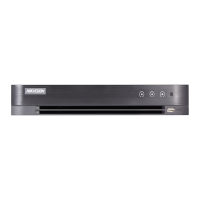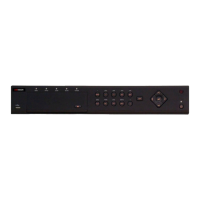
Do you have a question about the HIKVISION DS-7208HQHI-K2/P and is the answer not in the manual?
| HDD interface | Serial ATA |
|---|---|
| Maximum HDD capacity | 6000 GB |
| Number of HDDs supported | 2 |
| Power consumption (typical) | 60 W |
| Voltage | 12 V |
| Product color | Black |
| Audio output channels | 1.0 channels |
| Video compression formats | H.264, H.264+, H.265, H.265+ |
| Analog signal format system | NTSC, PAL |
| BNC input ports | 1 |
| Video input channels | 8 channels |
| USB 2.0 ports quantity | USB 2.0 ports have a data transmission speed of 480 Mbps, and are backwards compatible with USB 1.1 ports. You can connect all kinds of peripheral devices to them. |
| Ethernet LAN | Yes |
| Ethernet interface type | Fast Ethernet |
| Supported network protocols | TCP/IP, PPPoE, DHCP, Hik-Connect, DNS, DDNS, NTP, SADP, NFS, iSCSI, UPnP, HTTPS, ONVIF |
| Operating temperature (T-T) | -10 - 55 °C |
| Operating relative humidity (H-H) | 10 - 90 % |
| Weight | 17480 g |
|---|---|
| Dimensions (WxDxH) | 380 x 320 x 48 mm |
Overview of general features like camera connectivity and stream support.
Functions for managing hard disk drives, including capacity, RAID, and sleep modes.
Backing up record files via normal search, event search, and video clips.
Setting up motion, sensor, video loss, tampering, VCA, and exception alarms with response actions.
Procedures for safely powering the DVR on and off to ensure longevity.
Steps for initial device activation by setting an admin password for security.
How to configure and use a graphical unlock pattern for device login authentication.
Procedure to recover or reset the admin password using a GUID file.
Adding, activating, editing IP cameras, and connecting PoC cameras.
Instructions for connecting and managing PoC (Power over Coaxitron) cameras.
Functions available in live view, such as screen modes, mouse controls, and output switching.
Steps to configure PTZ parameters, including baud rate, data bit, and protocol.
How to set and manage PTZ presets, patrol paths, and movement patterns.
Settings for video encoding, including resolution, frame rate, bitrate, and compression.
Setting up schedules for continuous, event, motion, or alarm-triggered recording.
Setting up motion detection areas, sensitivity, and linking actions for recording.
Configuring alarm inputs, types, and linkage actions for triggered recording.
Setting up recording based on VCA events like face detection and intrusion.
Enabling dual recording to R/W and redundant HDDs for enhanced data safety.
Locking recorded files or setting HDDs to read-only to prevent overwriting.
Accessing and playing back recorded video files from the DVR.
Configuring motion detection parameters, areas, sensitivity, and arming schedules.
Configuring handling methods for external sensor alarms, including trigger channels and arming schedules.
Setting up detection for video loss and configuring alarm response actions.
Configuring detection for video tampering (lens cover) and setting alarm response actions.
Configuring face detection parameters, sensitivity, and linkage actions for surveillance.
Setting up vehicle detection for traffic monitoring, including license plate capture and alarm signals.
Defining virtual lines and directions for detecting objects crossing them and triggering alarms.
Configuring virtual regions for detecting intrusions and setting parameters like duration and sensitivity.
Initializing newly installed hard disk drives before they can be used for recording.
Common issues, their possible causes, and solutions for troubleshooting the DVR.










